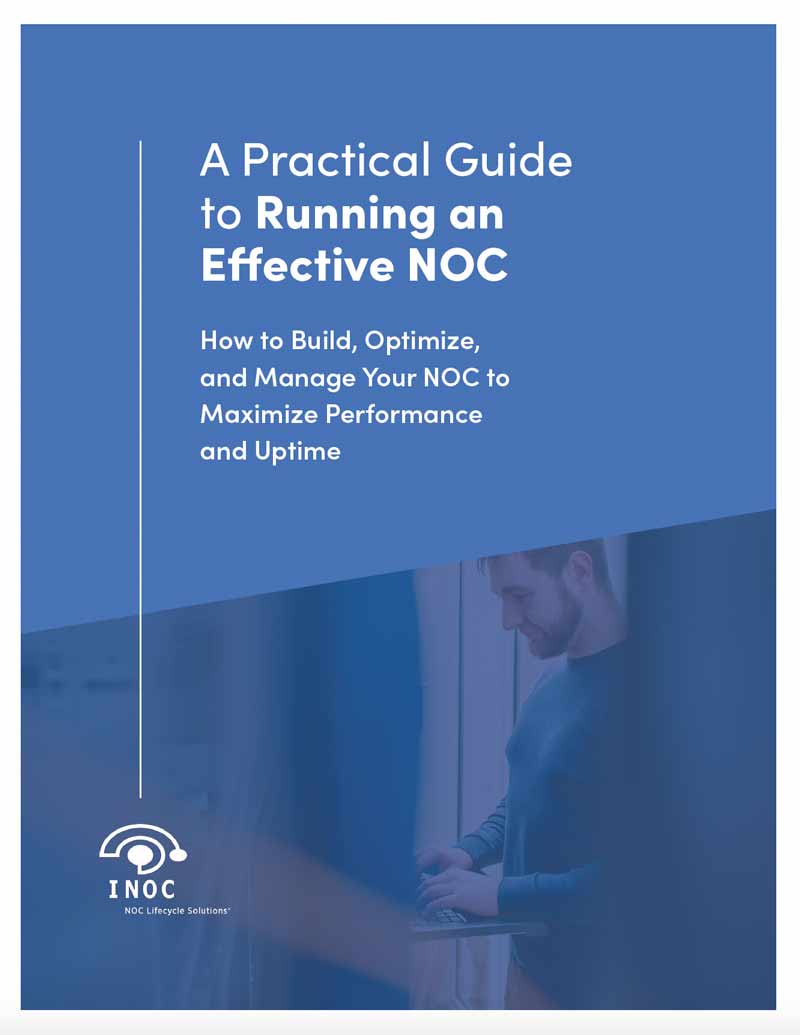As networks and IT infrastructures have grown exponentially more complex, the volume of alerts and events that Network Operations Center (NOC) teams must process has reached overwhelming levels.
This data deluge has transformed event correlation and automation from mere operational conveniences into absolute necessities. But what's truly possible with today's advanced correlation and automation technologies? And how can organizations leverage these capabilities to dramatically improve service quality while reducing operational burden?
In this guide, I'll walk through the current state of event correlation and automation in 2025, using our experience at INOC to illustrate what's achievable when these technologies are properly implemented and operationalized.
The Evolution of Event Correlation
Event correlation has evolved significantly from its humble beginnings as simple rule-based filtering.
Today's advanced correlation systems leverage multiple methodologies simultaneously to extract meaningful patterns from massive volumes of seemingly unrelated alerts.
From rules to intelligence
Traditional correlation relied primarily on static rules:
"If event X occurs within Y minutes of event Z, they're related."
While effective for simple scenarios, this approach quickly breaks down in complex environments where relationships aren't always obvious or consistent.
Modern correlation platforms like our Ops 3.0 system instead use a multi-layered approach:
- Topology-based correlation: Understanding the physical and logical relationships between infrastructure components.
- Temporal correlation: Identifying patterns in the timing and sequence of events.
- Machine learning-driven pattern recognition: Discovering non-obvious relationships based on historical incident data.
- Business service mapping: Correlating technical events to their business service impact.
This integrated approach delivers far more accurate and meaningful correlation than any single method could achieve alone.
For example, when a fiber cut occurs, our platform doesn't just identify that multiple devices have lost connectivity—it determines which specific circuit experienced the failure, which customers are impacted, and what redundant paths (if any) remain available.
CMDB Integration—the context engine
The true power of modern correlation emerges when it's combined with a comprehensive Configuration Management Database, or CMDB. Unlike basic asset inventories, today's CMDBs contain rich relationship data that provides essential context for correlation engines.
When an alert arrives, our correlation engine immediately enriches it with CMDB data, including:
- The specific configuration item's role and purpose
- Related components and dependencies
- Service mappings (which business services rely on this component)
- Historical performance and incident data
- Contact and ownership information
- Relevant runbooks and knowledge articles
This “contextual enrichment” turns what are otherwise raw alerts into meaningful incidents with clear business impact. For instance, rather than seeing "Router XYZ interface down," an engineer sees "Primary WAN connection down for Acme Corp's payment processing service; redundant link active but nearing capacity; previous failures caused by carrier equipment issues."
Self-Healing Capabilities
Perhaps the most exciting advancement in event correlation has been its integration with automation to create "self-healing" capabilities. These systems don't just identify problems—they actively resolve them without human intervention.
In our environment at INOC, we've implemented several tiers of automation that progressively reduce the need for manual intervention:
1. Auto-resolution of transient incidents
The simplest but highly effective form of automation handles short-duration incidents. When our platform detects that an alarm has cleared shortly after triggering, it can automatically close the incident without human intervention.
This capability includes important safeguards—for example, if the same alarm "flaps" multiple times in quick succession, the auto-resolution is suppressed and a NOC engineer is engaged, as the pattern indicates an underlying problem rather than a temporary glitch.
2. Automated data collection
Even when incidents require human resolution, automation significantly accelerates the process by gathering relevant diagnostic information before an engineer begins work.
For example, when a fiber optic link fails, our platform automatically collects performance data from immediately before the failure, providing critical context for troubleshooting. Similarly, for server incidents, it can gather CPU, memory, disk, and application log data to streamline diagnosis.
3. Full-cycle self-healing
The most advanced form of automation executes complete resolution workflows for specific incident types. These systems identify the issue, implement corrective actions, verify resolution, and document the entire process.
One real-world example from our implementation is Wi-Fi access point recovery. When our platform identifies the specific pattern of alarms indicating an access point failure, it:
- Automatically logs into the upstream switch
- Disables the port and Power over Ethernet (PoE)
- Waits a predetermined interval
- Re-enables the port and PoE
- Verifies the access point returns to service
- Fully documents the actions taken
This entire process occurs within minutes of the initial alert—far faster than a human engineer could execute the same workflow. Similar automation applies to optical networks, where toggling a laser can restore connectivity when an amplifier fails to register light properly after a momentary disruption.
These capabilities deliver measurable business benefits:
- Reduced Mean Time to Resolution (MTTR): Self-healing incidents are typically resolved 70-90% faster than those requiring human intervention.
- Improved service availability: Issues are resolved before many users even notice a problem.
- More efficient resource utilization: Engineers focus on complex problems that truly require human expertise.
- Consistent resolution quality: Automated procedures execute identically every time, eliminating human variation.
In one implementation for a telecommunications client, we found that approximately 30% of incidents could be resolved through automated means. This translated to hundreds of hours of saved engineering time monthly and a 35% reduction in average MTTR across all incidents.
The Intelligence Layer—AIOps and Machine Learning
Underpinning these advanced correlation and automation capabilities is a sophisticated layer of artificial intelligence for IT operations (AIOps). This technology applies machine learning algorithms to operational data, continuously improving its effectiveness over time.
Learning from historical patterns
Unlike static rule systems that require constant maintenance, machine learning-based correlation continuously refines its understanding based on operational experience. When our engineers confirm or reject proposed correlations, the system learns from these actions, becoming more accurate with each incident.
This learning capability extends to predictive analysis as well. By examining historical patterns, the system can identify the subtle precursors that often precede major failures, allowing for preventive action before service-impacting incidents occur.
Natural language processing for incident analysis
One particularly powerful application of AI in our platform is the use of natural language processing for incident summarization and analysis. This technology automatically condenses complex ticket histories (which can span dozens or even hundreds of updates) into concise summaries that provide engineers with immediate context.
For example, when a new engineer takes over an ongoing incident during a shift change, they can review an AI-generated summary that distills hours or days of troubleshooting into a few paragraphs. This capability reduces transition time from 10+ minutes to approximately 2 minutes—a significant improvement during critical outages.
Continuous improvement via machine learning
Perhaps most importantly, machine learning enables continuous enhancement of correlation and automation capabilities without requiring constant human tuning. As the system processes more incidents, it:
- Identifies new correlations between seemingly unrelated events
- Recognizes patterns that indicate opportunities for automated resolution
- Refines its understanding of normal vs. abnormal system behavior
- Improves its ability to predict potential failures before they impact service
This self-improving capability means that correlation and automation become more effective over time, creating a virtuous cycle of operational enhancement.
The Structured NOC
While technology provides powerful capabilities, its effectiveness ultimately depends on the operational framework in which it's deployed. This is where our Structured NOC approach creates substantial value.
Our correlation and automation capabilities are integrated into a tiered support structure that ensures optimal resource utilization:
- Automated Resolution: Handles routine, well-understood incidents without human intervention.
- Advanced Incident Management (AIM): Senior personnel who perform initial analysis for complex incidents.
- Tier 1 NOC: Engineers who handle standard troubleshooting and coordination.
- Tier 2/3 Specialists: Advanced engineers who address complex technical issues.
This structure ensures that incidents are handled at the appropriate level, with expensive specialist resources focused on tasks that genuinely require their expertise. The result is typically a 60-90% reduction in high-tier support activities compared to traditional NOC operations.
Process integration is also another big factor here. For correlation and automation to deliver their full potential, they must be integrated into comprehensive incident management processes. Key integration points include:
- Initial triage: Correlation engines feed enriched incidents to the AIM team for rapid impact assessment.
- Resolution workflows: Automation executes standardized procedures based on incident categorization.
- Knowledge management: Resolution data feeds back into the knowledge base to improve future responses.
- Continuous improvement: Performance metrics drive ongoing enhancement of correlation rules and automation scripts.
This process integration creates a continuous feedback loop where operational experience enhances technology capabilities, which in turn improve operational performance.
What's Next? The Future of Correlation and Automation
As we look ahead, several emerging trends promise to further enhance event correlation and automation capabilities:
- Enhanced predictive capabilities: While today's systems can identify some patterns that precede failures, future platforms will offer far more sophisticated predictive capabilities. By combining operational data with environmental factors, hardware lifecycle information, and performance trends, these systems will accurately forecast potential issues days or weeks before they impact service.
- Comprehensive self-healing: The scope of automated resolution will continue to expand, encompassing increasingly complex incidents. Technologies like robotic process automation (RPA) will enable systems to interact with a wider range of management interfaces, executing sophisticated recovery procedures that today require human intervention.
- Natural language interfaces: As generative AI continues to mature, NOC engineers will increasingly interact with correlation and automation systems through natural language interfaces. Rather than navigating complex dashboards, engineers will simply ask questions like "What caused the network slowdown in the east region yesterday?" and receive comprehensive analysis in response.
Final Thoughts and Next Steps
The correlation and automation capabilities available in 2025 represent a fundamental transformation in how NOC operations can be conducted. By implementing these technologies effectively, organizations can:
- Dramatically reduce alert noise and focus on meaningful incidents.
- Accelerate identification and resolution of service-impacting issues.
- Enable true self-healing for a growing range of common problems.
- Optimize resource utilization by matching tasks to appropriate skill levels.
- Create a continuous improvement cycle that enhances service quality over time.
The result is not just better operational metrics but meaningful business impact: reduced downtime, optimized resources, and enhanced customer satisfaction.
As IT environments continue to grow in complexity, the gap between organizations leveraging advanced correlation and automation and those relying on traditional approaches will only widen. The question is no longer whether these capabilities are valuable, but how quickly they can be implemented to deliver competitive advantage.
If you're interested in exploring how modern event correlation and automation could transform your NOC operations, reach out to our team for a consultation. We can discuss your specific challenges and how our Ops 3.0 Platform and operational expertise might help address them.
Whether you're looking to enhance your existing NOC or considering outsourced support, we'd be happy to share our experience and provide insight into what's possible with today's technology. Contact us to start the conversation.

Free white paper A Practical Guide to Running an Effective NOC
Download our free white paper and learn how to build, optimize, and manage your NOC to maximize performance and uptime.







